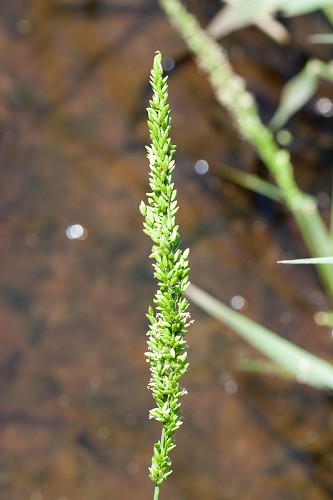Difference between revisions of "Sacciolepis striata"
(→Fire ecology) |
HaleighJoM (talk | contribs) (→Ecology) |
||
| (3 intermediate revisions by 2 users not shown) | |||
| Line 43: | Line 43: | ||
<!--Timing off flowering, fruiting, seed dispersal, and environmental triggers. Cite PanFlora website if appropriate: http://www.gilnelson.com/PanFlora/ --> | <!--Timing off flowering, fruiting, seed dispersal, and environmental triggers. Cite PanFlora website if appropriate: http://www.gilnelson.com/PanFlora/ --> | ||
<!--===Seed dispersal===--> | <!--===Seed dispersal===--> | ||
| − | |||
===Seed bank and germination=== | ===Seed bank and germination=== | ||
Seeds will begin to germinate in summer and through the fall.<ref name= "USDA"> [https://plants.usda.gov/core/profile?symbol=CEAM USDA Plant Database]</ref> | Seeds will begin to germinate in summer and through the fall.<ref name= "USDA"> [https://plants.usda.gov/core/profile?symbol=CEAM USDA Plant Database]</ref> | ||
| + | ===Fire ecology===<!--Fire tolerance, fire dependence, adaptive fire responses--> | ||
| + | The species was originally thought to have no tolerance for fire;<ref name= "USDA"> [https://plants.usda.gov/core/profile?symbol=CEAM USDA Plant Database]</ref> however, populations of ''Sacciolepis striata'' have been known to persist through repeated annual burning.<ref>Platt, W.J., R. Carter, G. Nelson, W. Baker, S. Hermann, J. Kane, L. Anderson, M. Smith, K. Robertson. 2021. Unpublished species list of Wade Tract old-growth longleaf pine savanna, Thomasville, Georgia.</ref> | ||
| + | <!--===Pollination===--> | ||
| + | <!--===Herbivory and toxicology===<!--Common herbivores, granivory, insect hosting, poisonous chemicals, allelopathy, etc--> | ||
| + | <!--===Diseases and parasites===--> | ||
| − | == | + | ==Conservation, cultivation, and restoration== |
| − | |||
| − | |||
| − | |||
| − | |||
| − | |||
| − | == | + | ==Cultural use== |
| − | |||
==Photo Gallery== | ==Photo Gallery== | ||
<gallery widths=180px> | <gallery widths=180px> | ||
</gallery> | </gallery> | ||
==References and notes== | ==References and notes== | ||
Latest revision as of 15:48, 15 July 2022
Common names: American Cupscale [1]
| Sacciolepis striata | |
|---|---|

| |
| Photo by John Gwaltney hosted at Southeastern Flora.com | |
| Scientific classification | |
| Kingdom: | Plantae |
| Division: | Magnoliophyta - Flowering plants |
| Class: | Liliopsida - Moncots |
| Order: | Poales |
| Family: | Poaceae |
| Genus: | Sacciolepis |
| Species: | S. striata |
| Binomial name | |
| Sacciolepis striata (L.) Nash | |

| |
| Natural range of Sacciolepis striata from USDA NRCS Plants Database. | |
Contents
Taxonomic Notes
Synonym: none
Variety: none
Description
S. striata is a perennial graminoid of the Poaceae family that is native to North America.[1]
Distribution
S. striata is found in the southeastern United States as far west as Texas and as far north as Maine.[1]
Ecology
Habitat
Habitats that S. striata is found include marshes, interdune swales, ditches, and swamps.[2] Specimens have been collected from disturbed sandy areas, marshes, edge of dam, edge of lake, open area with palms, salt marsh, disturbed sandy pat of abandoned fields, clearing of pine flatwoods, and cypress gum swamp.[3]
Soils that are habitable for S. striata are medium to fine in texture.[1]
The grass has a medium tolerance for drought and is intolerant of shade.[1]
Phenology
S. striata has been observed to flower in July and October.[4]
Seed bank and germination
Seeds will begin to germinate in summer and through the fall.[1]
Fire ecology
The species was originally thought to have no tolerance for fire;[1] however, populations of Sacciolepis striata have been known to persist through repeated annual burning.[5]
Conservation, cultivation, and restoration
Cultural use
Photo Gallery
References and notes
- ↑ 1.0 1.1 1.2 1.3 1.4 1.5 1.6 USDA Plant Database
- ↑ Weakley, A. S. (2015). Flora of the Southern and Mid-Atlantic States. Chapel Hill, NC, University of North Carolina Herbarium.
- ↑ URL: http://herbarium.bio.fsu.edu. Last accessed: June 2018. Collectors: L.C. Anderson, Lisa Keppner, Ed Keppner, Roy Komarek, R.K. Godfrey, D.B. Ward, S.S. Ward, R.E. Perdue Jr., R. Kral, Richard Mitchell, A.F> Clewell, Cecil Slaughter, M. Minno, Gary Knight, A.H. Curtiss, J. P. Gillespie, P.L. Redfearn, Andre Clewell, O. Lakela, Jean Wooten, R.A. Norris, R.F. Doren, J.M. Kane, Rodie White, Travis MacClendon, Karen MacClendon, Herbert Kessler, Tina, Kessler, M. Darst, R. Mattson, L. Peed. States and counties: Florida (Wakulla, Bay, Leon, Gadsden, Columbia, Manatee, St. Lucie, Lee, Palm Beach, Franklin, Collier, Putnam, Charlotte, Brevard, Flager, Jackson, Okaloosa, Madison, Taylor, Walton, Dixie, Nassau, Marion, Washington, Cilchrist, Gulf) Georgia (Thomas, Grady)
- ↑ Nelson, G. PanFlora: Plant data for the eastern United States with emphasis on the Southeastern Coastal Plains, Florida, and the Florida Panhandle. www.gilnelson.com/PanFlora/ Accessed: 29 MAY 2018
- ↑ Platt, W.J., R. Carter, G. Nelson, W. Baker, S. Hermann, J. Kane, L. Anderson, M. Smith, K. Robertson. 2021. Unpublished species list of Wade Tract old-growth longleaf pine savanna, Thomasville, Georgia.